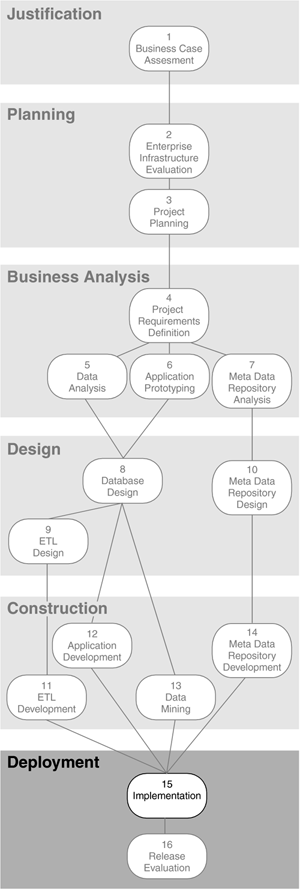Things to Consider Preparing for Production  Have we defined all the production libraries and production databases? Have we defined all the production libraries and production databases?  Are the daily, weekly, and monthly extract/transform/load (ETL) processes on the job scheduler? Are the daily, weekly, and monthly extract/transform/load (ETL) processes on the job scheduler?  Are the regularly scheduled application report programs on the job scheduler? Are the regularly scheduled application report programs on the job scheduler?  Are the regularly scheduled meta data repository programs on the job scheduler? Are the regularly scheduled meta data repository programs on the job scheduler?  Is the operations staff ready to take over? Is the operations staff ready to take over?  Have they approved the quality assurance (QA) test results? Do they have any concerns? Have they approved the quality assurance (QA) test results? Do they have any concerns?  Do we have to write operating procedures for the operations staff? For all components of the BI application? Or just for the ETL process? Do we have to write operating procedures for the operations staff? For all components of the BI application? Or just for the ETL process?  When will we copy all programs into the production libraries? When will we copy all programs into the production libraries?  When will we load the production databases? When will we load the production databases? Security Considerations  What types of security measures do we need? What are we securing? What types of security measures do we need? What are we securing?  How are we securing the data? The applications? The tools? The interfaces? How are we securing the data? The applications? The tools? The interfaces?  Do the security measures have to include encryption and decryption, especially for the Web-enabled access and analysis portion of the BI application? Do the security measures have to include encryption and decryption, especially for the Web-enabled access and analysis portion of the BI application?  Are single- user authentication services of an enterprise information portal part of this BI application? Are single- user authentication services of an enterprise information portal part of this BI application? Database Maintenance  What is our backup and recovery procedure? What is our backup and recovery procedure?  What is our disaster recovery procedure? What is our disaster recovery procedure?  How will database performance monitoring take place? What tools will be used? Who is responsible for monitoring the databases? How will database performance monitoring take place? What tools will be used? Who is responsible for monitoring the databases?  How will we know if we have met the service-level agreement (SLA) for performance? How will we know if we have met the service-level agreement (SLA) for performance?  How will we monitor growth in usage and growth in data volume? How will we monitor growth in usage and growth in data volume? Training and Support  Have the business people received training on using the BI application? Have the business people received training on using the BI application?  Have the business people received training on using the meta data repository? Have the business people received training on using the meta data repository?  Have the "power users" received training on writing efficient queries in Structured Query Language (SQL)? Have the "power users" received training on writing efficient queries in Structured Query Language (SQL)?  Is the help desk staff geared up to mentor the business people in their use of the BI application, including the meta data repository? Is the help desk staff geared up to mentor the business people in their use of the BI application, including the meta data repository?  Has the help desk staff received sufficient training? Has the help desk staff received sufficient training?  If there is no help desk, who will support the business people? If there is no help desk, who will support the business people? | 
 Have we defined all the production libraries and production databases?
Have we defined all the production libraries and production databases?